Determination of Paleoenvironmental Changes by Using δ13C, 14C Dating and Rb/Sr Ratio in Critical Karst Area of Yunnan-Guizhou Plateau, Southwestern China
Abstract
1. Introduction
2. Materials and Methods
2.1. Description of Study Area
2.2. Soil Profile and Sample Collection
2.3. Soil Sample Preparation and Analysis
2.4. The 14C Radioisotope Determination
2.5. Statistical Analysis
3. Results
3.1. Vertical Depth Distribution of pH, TOC, 14C Age and Rb/Sr Ratios in Soil Profiles
3.2. Isotopic Composition and Distribution
4. Discussion
4.1. Physiochemical Properties of Soil Profiles in Karst Environments
4.2. Stable Carbon Isotope and Vegetation History
4.3. Paleoenvironmental Interpretation from δ13C, δ14C and Rb/Sr Ratio
4.4. Effect of East Asian Summer Monsoon (EAM) and Indian Ocean Summer Monsoon (ISM) on δ13C Values
5. Conclusions
Author Contributions
Funding
Data Availability Statement
Acknowledgments
Conflicts of Interest
References
- Amundson, R.; Richter, D.D.; Humphreys, G.S.; Jobbágy, E.G.; Gaillardet, J. Coupling between Biota and Earth Materials in the Critical Zone. Elements 2007, 3, 327–332. [Google Scholar] [CrossRef]
- Leopold, M.; Völkel, J.; Dethier, D.; Huber, J.; Steffens, M. Characteristics of a paleosol and its implication for the Critical Zone development, Rocky Mountain Front Range of Colorado, USA. Appl. Geochem. 2011, 26, S72–S75. [Google Scholar] [CrossRef]
- Nordt, L.C.; Hallmark, C.T.; Driese, S.G.; Dworkin, S.I.; Atchley, S.C. Biogeochemical characterization of a lithified paleosol: Implications for the interpretation of ancient Critical Zones. Geochim. Cosmochim. Acta 2012, 87, 267–282. [Google Scholar] [CrossRef]
- Nordt, L.C.; Hallmark, C.T.; Driese, S.G.; Dworkin, S.I. Multianalytical pedosystem approach to characterizing and interpreting the fossil record of soils. In New Frontiers in Paleopedology and Terrestrial Paleoclimatology; Driese, S.G., Nordt, L.C., Eds.; SEPM Special Publication No. 104; SEPM: Tulsa, OK, USA, 2013; pp. 47–62. [Google Scholar] [CrossRef]
- Marin-Spiotta, E.; Chaopricha, N.T.; Plante, A.F.; Diefendorf, A.F.; Mueller, C.W.; Grandy, A.S.; Mason, J.A. Long-term stabilization of deep soil carbon by fire and burial during early Holocene climate change. Nat. Geosci. 2014, 7, 428–432. [Google Scholar] [CrossRef]
- Beverly, E.J.; Ashley, G.M.; Driese, S.G. Reconstruction of a Pleistocene paleocatena using micromorphology and geochemistry of lake margin paleo-Vertisols, Olduvai Gorge, Tanzania. Quat. Int. 2014, 322–323, 78–94. [Google Scholar] [CrossRef]
- Beverly, E.J.; William EL Stinchcomb, G.E. Paleopedology as a Tool for Reconstructing Paleoenvironments and Paleoecology. In Methods in Paleoecology; Croft, D.A., Simpson, S.W., Su, D.F., Eds.; Reconstructing Cenozoic Terrestrial Environments and Ecological Communities, Vertebrate Paleobiology and Paleoanthropology; Springer: Berlin/Heidelberg, Germany, 2018. [Google Scholar] [CrossRef]
- Berke, M.A. Reconstructing Terrestrial Paleoenvironments Using Sedimentary Organic Biomarkers. In Methods in Paleoecology; Croft, D.A., Simpson, S.W., Su, D.F., Eds.; Reconstructing Cenozoic Terrestrial Environments and Ecological Communities; Springer: Cham, Switzerland, 2017; pp. 121–149. [Google Scholar]
- Cerling, T.E. Stable isotope evidence for hominin environments in Africa. In Treatise on Geo-Chemistry; Cerling, T.E., Ed.; Pergamon: Oxford, UK, 2014; Volume 14: Archaeology and Anthropology, pp. 157–167. [Google Scholar]
- Levin, N.E. Environment and Climate of Early Human Evolution. Annu. Rev. Earth Planet. Sci. 2015, 43, 405–429. [Google Scholar] [CrossRef]
- Nordt, L.C. Stable C and O isotopes in soils: Applications for archaeological research. In Earth-Sciences and Archaeology; Goldberg, P., Holliday, V., Ferring, R., Eds.; Springer: Berlin/Heidelberg, Germany, 2001; pp. 419–445. [Google Scholar]
- Sheldon, N.D.; Tabor, N.J. Quantitative paleoenvironmental and paleoclimatic reconstruction using paleosols. Earth-Science Rev. 2009, 95, 1–52. [Google Scholar] [CrossRef]
- Tabor, N.J.; Myers, T.S. Paleosols as Indicators of Paleoenvironment and Paleoclimate. Annu. Rev. Earth Planet. Sci. 2015, 43, 333–361. [Google Scholar] [CrossRef]
- Zamanian, K.; Pustovoytov, K.; Kuzyakov, Y. Pedogenic carbonates: Forms and formation processes. Earth-Science Rev. 2016, 157, 1–17. [Google Scholar] [CrossRef]
- Xi, C. On the red weathering crust of South China. Quat. Stud. 1991, 11, 103–117. [Google Scholar] [CrossRef]
- Zhu, X.M. Red residua and red soils in southern China. Quat. Sci. 1993, 1, 75–84. [Google Scholar]
- Boutton, T.W. Stable isotope ratios of natural materials: II. Atmospheric, terrestrial, marine, and freshwater environments. In Carbon Isotope Techniques; Coleman, D.C., Fry, B., Eds.; Academic Press: New York, NY, USA, 1991; pp. 173–185. [Google Scholar] [CrossRef]
- Trumbore, S.E. Comparison of carbon dynamics in tropical and temperate soils using radiocarbon measurements. Glob. Biogeochem. Cycles 1993, 7, 275–290. [Google Scholar] [CrossRef]
- Trumbore, S.E.; Davidson, E.; De Camargo, P.B.; Nepstad, D.C.; Martinelli, L. Belowground cycling of carbon in forests and pastures of eastern Amazonia. Glob. Biogeochem. Cycles 1995, 9, 515–528. [Google Scholar] [CrossRef]
- Trumbore, S.E. Age of soil organic matter and soil respiration: Radiocarbon constraints on belowground C dynamics. Ecol. Appl. 2000, 10, 399–411. [Google Scholar] [CrossRef]
- Pessenda, L.C.R.; Gouveia, S.E.M.; Gomes, M.B.M.; Aravena, R.; Boulet, R.; Ribeiro, A. Studies of palaeovegetation changes in the central Amazon by carbon isotopes of soil organic matter. In Proceedings of the International Simposium on Isotope Techniques in the Study of Past and Current Environmental Changes in the Hydrosphere and Atmosphere, Vienna, Austria, 14–18 April 1997; Murphy, P., Ed.; IAEA: Vienna, Austria, 1997. [Google Scholar]
- Pessenda, L.C.R.; Valencia, E.P.E.; Camargo, P.B.; Telles, E.C.C.; Martinelli, L.A.; Cerri, C.C.; Aravena, R.; Rozanski, K. Natural Radiocarbon Measurements in Brazilian Soils Developed on Basic Rocks. Radiocarbon 1996, 38, 203–208. [Google Scholar] [CrossRef]
- Pessenda, L.C.; Gomes, B.M.; Aravena, R.; Ribeiro, A.S.; Boulet, R.; Gouveia, S.E. The carbon isotope record in soils along a forestcerrado ecosystem transect: Implications for vegetation changes in the Rondonia state, southwestern Brazilian Amazon region. Holocene 1998, 8, 599–603. [Google Scholar] [CrossRef]
- Sanaiotti, T. The Woody Flora and Soils of Seven Brazilian Amazonian Dry Savanna Areas. Ph.D. Thesis, University of Stirling, Scotland, UK, 1996; 148p. [Google Scholar]
- Selvaraj, K.; Chen, C.T.A.; Lou, J.-Y. Holocene East Asian monsoon variability: Links to solar and tropical Pacific forcing. Geophys. Res. Lett. 2007, 34, L01703. [Google Scholar] [CrossRef]
- Yang, T.-N.; Lee, T.-Q.; Meyers, P.A.; Song, S.-R.; Kao, S.-J.; Löwemark, L.; Chen, R.-F.; Chen, H.-F.; Wei, K.-Y.; Fan, C.-W.; et al. Variations in monsoonal rainfall over the last 21 kyr inferred from sedimentary organic matter in Tung-Yuan Pond, southern Taiwan. Quat. Sci. Rev. 2011, 30, 3413–3422. [Google Scholar] [CrossRef]
- Chen, J.; An, Z.; Liu, L.; Ji, G.; Yang, J. The chemical composition variations of Loess Plateau dust-fall and the chemical weathering of inland Asia since 2.5 Ma. Sci. China D 2001, 31, 136–145. (In Chinese) [Google Scholar]
- Jin, Z.; Cao, J.; Wu, J.; Wang, S. A Rb/Sr record of catchment weathering response to Holocene climate change in Inner Mongolia. Earth Surf. Process. Landforms 2006, 31, 285–291. [Google Scholar] [CrossRef]
- Jin, Z.; Li, F.; Cao, J.; Wang, S.; Yu, J. Geochemistry of Daihai Lake sediments, Inner Mongolia, north China: Implications for provenance, sedimentary sorting, and catchment weathering. Geomorphology 2006, 80, 147–163. [Google Scholar] [CrossRef]
- Plank, T.; Langmuir, C.H. The chemical composition of subducting sediment and its consequences for the crust and mantle. Chem. Geol. 1998, 145, 325–394. [Google Scholar] [CrossRef]
- Bauer, A.; Velde, B.D. Geochemistry at the Earth’s Surface: Movement of Chemical Elements; Springer: Berlin/Heidelberg, Germany; New York, NY, USA; London, UK, 2014. [Google Scholar]
- Collins, R.N.; Kinsela, A.S. The aqueous phase speciation and chemistry of cobalt in terrestrial environments. Chemosphere 2010, 79, 763–771. [Google Scholar] [CrossRef] [PubMed]
- Chen, J.; An, Z.; Wang, Y.; Ji, J.; Chen, Y.; Lu, H. Distribution of Rb and Sr in the Luochuan loess-paleosol sequence of China during the last 800 ka. Sci. China Ser. D: Earth Sci. 1999, 42, 225–232. [Google Scholar] [CrossRef]
- Yuan, D.X. Karst in southwestern China and its comparison with karst in North China. Quat. Res. 1992, 4, 352–361. [Google Scholar]
- Guizhou Provincial Geological Survey Team. Dictionary of Stratigraphic Terms of Guizhou; Guizhou Science and Technology Press: Guiyang, China, 1995; p. 30. [Google Scholar] [CrossRef]
- Can, J.H.; Yuan, D.X.; Tong, L.Q. Characteristics of karst ecosystem in southwest China and comprehensive control of rocky desertification. Grassl. Sci. 2008, 25, 40–50. [Google Scholar] [CrossRef]
- Huang, J. Yunnan Stone Forest Karst Mountain Vegetation and Soil Degradation Characteristics. Master’s Thesis, Nanjing Forestry University, Nanjing, China, 2009. [Google Scholar]
- Liu, J. Research on Karst Area Forest Vegetation Climate Characteristics. Master’s Thesis, Yunnan Normal University, Kunming, China, 2015. [Google Scholar]
- Soil Survey Staff. Keys to Soil Taxonomy, 12th ed.; USDA Natural Resources Conservation Service: Washington, DC, USA, 2014; pp. 161–195. [Google Scholar]
- Ji, H.; Chang, C.; Beckford, H.O.; Song, C.; Blake, R.E. New perspectives on lateritic weathering process over karst area—Geochemistry and Si-Li isotopic evidence. Catena 2020, 198, 105022. [Google Scholar] [CrossRef]
- Chang, C.; Beckford, H.O.; Ji, H. Indication of Sr Isotopes on Weathering Process of Carbonate Rocks in Karst Area of Southwest China. Sustainability 2022, 14, 4822. [Google Scholar] [CrossRef]
- Zhu, S.F.; Liu, C.Q. Vertical patterns of stable carbon isotope in soils and particle-size fractions of karst areas, Southwest China. Environ. Geol. 2006, 50, 1119–1127. [Google Scholar] [CrossRef]
- Midwood, A.J.; Boutton, T.W. Soil carbonate decomposition by acid has little effect on δ13C of organic matter. Soil Biol. Biochem. 1998, 30, 1301–1307. [Google Scholar] [CrossRef]
- GB/T 14506.30-2010; Methods for Chemical Analysis of Silicate Rocks—Part 30: Determination of 44 Elements. National Standardization Technical Committee of Land and Resources: Beijing, China, 2011.
- Zhou, W.; Zhao, X.; Xuefeng, L.; Lin, L.; Zhengkun, W.; Peng, C.; Wengnian, Z.; Chunhai, H. The 3MV Multi-Element AMS in Xi’an, China: Unique Features and Preliminary Tests. Radiocarbon 2006, 48, 285–293. [Google Scholar] [CrossRef]
- Cheng, P.; Burr, G.S.; Zhou, W.; Chen, N.; Hou, Y.; Du, H.; Fu, Y.; Lu, X. The deficiency of organic matter 14C dating in Chinese Loess-paleosol sample. Quat. Geochronol. 2019, 56, 101051. [Google Scholar] [CrossRef]
- Hong, S.; Gan, P.; Chen, A. Environmental controls on soil pH in planted forest and its response to nitrogen deposition. Environ. Res. 2019, 172, 159–165. [Google Scholar] [CrossRef]
- Beckford, H.O.; Chu, H.; Song, C.; Chang, C.; Ji, H. Geochemical characteristics and behaviour of elements during weathering and pedogenesis over karst area in Yunnan-Guizhou Plateau, southwestern China. Environ. Earth Sci. 2021, 80, 61. [Google Scholar] [CrossRef]
- Cao, X.; Wu, P.; Cao, Z. Element geochemical characteristics of a soil developed on dolomite in central Guizhou, southern China: Implications for parent materials. Acta Geochem. 2016, 35, 445–462. [Google Scholar] [CrossRef]
- Bowling, D.R.; Pataki, D.E.; Randerson, J.T. Carbon isotopes in terrestrial ecosystem pools and CO2 fluxes. New Phytol. 2008, 178, 24–40. [Google Scholar] [CrossRef]
- Du, B.; Liu, C.; Kang, H.; Zhu, P.; Yin, S.; Shen, G.; Hou, J.; Ilvesniemi, H. Climatic Control on Plant and Soil δ13C along an Altitudinal Transect of Lushan Mountain in Subtropical China: Characteristics and Interpretation of Soil Carbon Dynamics. PLoS ONE 2014, 9, e86440. [Google Scholar] [CrossRef]
- Malone, E.T.; Abbott, B.W.; Klaar, M.; Kidd, C.; Sebilo, M.; Milner, A.; Pinay, G. Decline in ecosystem delta 13C and mid-successional nitrogen loss in a two-century glacial chronosequence. Ecosystems 2018, 21, 1659–1675. [Google Scholar] [CrossRef]
- Wang, C.; Wei, H.; Liu, D.; Luo, W.; Hou, J.; Cheng, W.; Han, X.; Bai, E. Depth profiles of soil carbon isotopes along a semi-arid grassland transect in northern China. Plant Soil 2017, 417, 43–52. [Google Scholar] [CrossRef]
- Craine, J.; Fierer, N.; McLauchlan, K. Widespread coupling between the rate and temperature sensitivity of organic matter decay. Nat. Geosci. 2010, 3, 854–857. [Google Scholar] [CrossRef]
- Zacháry, D.; Filep, T.; Jakab, G.; Molnár, M.; Kertész, T.; Király, C.; Hegyi, I.; Gáspár, L.; Szalai, Z. Carbon Isotope Measurements to Determine the Turnover of Soil Organic Matter Fractions in a Temperate Forest Soil. Agronomy 2020, 10, 1944. [Google Scholar] [CrossRef]
- Zhang, D.; Hui, D.; Luo, Y.; Zhou, G. Rates of litter decomposition in terrestrial ecosystems: Global patterns and controlling factors. J. Plant Ecol. 2008, 1, 85–93. [Google Scholar] [CrossRef]
- Ji, H.B.; Wang, S.J.; Ouyang, Z.Y.; Zhang, S.; Sun, C.X.; Liu, X.M.; Zhou, D.Q. Geochemistry of red residua underlying dolomites in karst terrains of Yunnan–Guizhou Plateau: I. The formation of the Pingba profile. Chem. Geol. 2004, 203, 1–27. [Google Scholar] [CrossRef]
- Wei, X.; Ji, H.; Li, D.; Zhang, F.; Wang, S. Material source analysis and element geochemical research about two types of representative bauxite deposits and terra rossa in western Guangxi, southern China. J. Geochem. Explor. 2013, 133, 68–87. [Google Scholar] [CrossRef]
- Song, C.; Ji, H.; Beckford, H.O.; Chang, C.; Wang, S. Assessment of chemical weathering and physical erosion along a hillslope, southwest China. Catena 2019, 182, 104133. [Google Scholar] [CrossRef]
- Jobbágy, E.G.; Jackson, R.B. The vertical distribution of soil organic carbon and its relation to climate and vegetation. Ecol. Appl. 2000, 10, 423–436. [Google Scholar] [CrossRef]
- Wiesmeier, M.; Spörlein, P.; Geuß, U.; Hangen, E.; Haug, S.; Reischl, A.; Schilling, B.; von Lützow, M.; Kögel-Knabner, I. Soil organic carbon stocks in southeast Germany (Bavaria) as affected by land use, soil type and sampling depth. Glob. Chang. Biol. 2012, 18, 2233–2245. [Google Scholar] [CrossRef]
- Chen, Q.Q.; Shen, C.D.; Sun, Y.M.; Peng, S.L. Mechanism of distribution of soil organic matter with depth due to evolution of soil profiles at the Dinghushan Natural Reserve. Acta. Pedol. Sin. 2005, 42, 1–8. [Google Scholar]
- Han, G.; Li, F.; Tang, Y. Variations in soil organic carbon contents and isotopic compositions under different land uses in a typical karst area in Southwest China. Geochem. J. 2015, 49, 63–71. [Google Scholar] [CrossRef]
- Liu, M.; Han, G.; Zhang, Q.; Song, Z. Variations and Indications of δ13CSOC and δ15NSON in Soil Profiles in Karst Critical Zone Observatory (CZO), Southwest China. Sustainability 2019, 11, 2144. [Google Scholar] [CrossRef]
- Luo, W.; Wang, S.; Xie, X. A comparative study on the stable isotopes from precipitation to speleothem in four caves of Guizhou, China. Geochemistry 2013, 73, 205–215. [Google Scholar] [CrossRef]
- Boutton, T.W.; Archer, S.R.; Midwood, A.J.; Zitzer, S.F.; Bol, R. δ13C values of soil organic carbon and their use in documenting vegetation change in a subtropical savanna ecosystem. Geoderma 1998, 82, 5–41. [Google Scholar] [CrossRef]
- Kelly, E.F.; Amundson, R.G.; Marino, B.D.; DeNiro, M.J. Stable Carbon Isotopic Composition of Carbonate in Holocene Grassland Soils. Soil Sci. Soc. Am. J. 1991, 55, 1651–1658. [Google Scholar] [CrossRef]
- Ehleringer, J.R.; Buchmann, N.; Flanagan, L.B. Carbon Isotope Ratios in Belowground Carbon Cycle Processes. Ecol. Appl. 2000, 10, 412–422. [Google Scholar] [CrossRef]
- Garten, C.T.; Cooper, L.W.; Post, W.M., III; Hanson, P.J. Climate controls on forest soil C isotope ratios in the southern Appalachian Mountains. Ecology 2000, 81, 1108–1119. [Google Scholar] [CrossRef]
- Powers, J.S.; Schlesinger, W.H. Geographic and vertical patterns of stable carbon isotopes in tropical rain forest soils of Costa Rica. Geoderma 2002, 109, 141–160. [Google Scholar] [CrossRef]
- McCorkle, E.P.; Berhe, A.A.; Hunsaker, C.T.; Johnson, D.W.; McFarlane, K.J.; Fogel, M.L.; Hart, S.C. Tracing the source of soil organic matter eroded from temperate forest catchments using carbon and nitrogen isotopes. Chem. Geol. 2016, 445, 172–184. [Google Scholar] [CrossRef]
- Qin, J.; Yuan, D.; Cheng, H.; Lin, Y.; Zhang, M.; Wang, F.; Edwards, R.L.; Wang, H.; Ran, J. Dryas and early-mid Holocene climate abrupt events: The oxygen isotope record of stalagmites in Maolan, Guizhou. Sci. China Ser. D 2004, 34, 69–74. [Google Scholar]
- Liu, J.; Ni, Y.; Chu, G. Major climate events in the Quaternary. Quat. Res. 2001, 21, 239–248. [Google Scholar] [CrossRef]
- Wynn, J.G.; Harden, J.W.; Fries, T.L. Stable carbon isotope depth profiles and soil organic carbon dynamics in the lower Mississippi Basin. Geoderma 2006, 131, 89–109. [Google Scholar] [CrossRef]
- Hong, Y.; Hong, B.; Lin, Q.; Shibata, Y.; Hirota, M.; Zhu, Y.; Leng, X.; Wang, Y.; Wang, H.; Yi, L. Inverse phase oscillations between the East Asian and Indian Ocean summer monsoons during the last 12000 years and paleo-El Niño. Earth Planet. Sci. Lett. 2005, 231, 337–346. [Google Scholar] [CrossRef]
- Gao, Y.X.; Xu, S.Y. Some Problems of East Asian Monsoon; Science Press: Beijing, China, 1962; pp. 1–49. [Google Scholar]
- Chen, Q.Q.; Shen, C.D.; Sun, Y.M.; Peng, S.L.; Yi, W.X.; Li, Z.A.; Jiang, M.T. Spatial and temporal distribution of carbon isotopes in soil organic matter at the Dinghushan Biosphere Reserve, South China. Plant Soil 2005, 273, 115–128. [Google Scholar] [CrossRef]
- Tao, F.; Hong, Y.; Jiang, H. Climatic change over the past 8000 years in Caohai District, Guizhou. Chin. Sci. Bull. 1997, 42, 409–413. [Google Scholar] [CrossRef]
- Li, B.; Yuan, D.; Lin, Y.S.; Qin, Y.S.; Zhang, M.L. The Paleoclimatic Changes of Guilin Area since 40,000 a B.P. and Its Dynamical Mechanism. Acta GeoScientia Sin. 2000, 21–23. [Google Scholar]
- Gasse, F.; Arnold, M.; Fontes, J.C.; Fort, M.; Gibert, E.; Huc, A.; Li, B.; Li, Y.; Liu, Q.; Mélières, F.; et al. A 13,000-year climate record from western Tibet. Nature 1991, 353, 742–745. [Google Scholar] [CrossRef]
- Lister, G.S.; Kelts, K.; Chen, K.Z.; Yu, J.Q.; Niessen, F. Lake Qinghai, China: Closed-basin like levels and the oxygen isotope record for ostracoda since the latest Pleistocene. Palaeogeogr. Palaeoclim. Palaeoecol. 1991, 84, 141–162. [Google Scholar] [CrossRef]
- Bond, G.; Heinrich, H.; Broecker, W.; Labeyrie, L.; McManus, J.; Andrews, J.; Huon, S.; Jantschik, R.; Clasen, S.; Simet, C.; et al. Evidence for massive discharges of icebergs into the North Atlantic ocean during the last glacial period. Nature 1992, 360, 245–249. [Google Scholar] [CrossRef]
- Gasse, F.; Van Campo, E. Abrupt post-glacial climate events in West Asia and North Africa monsoon domains. Earth Planet. Sci. Lett. 1994, 126, 435–456. [Google Scholar] [CrossRef]
- Sirocko, F.; Garbe-Schönberg, D.; McIntyre, A.; Molfino, B. Teleconnections Between the Subtropical Monsoons and High-Latitude Climates During the Last Deglaciation. Science 1996, 272, 526–529. [Google Scholar] [CrossRef]
- GISP2. The Greenland Summit Ice Cores, National Snow and Ice Data Center, [CD-ROM] ed; University of Colorado at Boulder, and the World Data Center—A for Paleoclimatology, National Geophysical Data Center: Boulder, CO, USA, 1997. [Google Scholar]
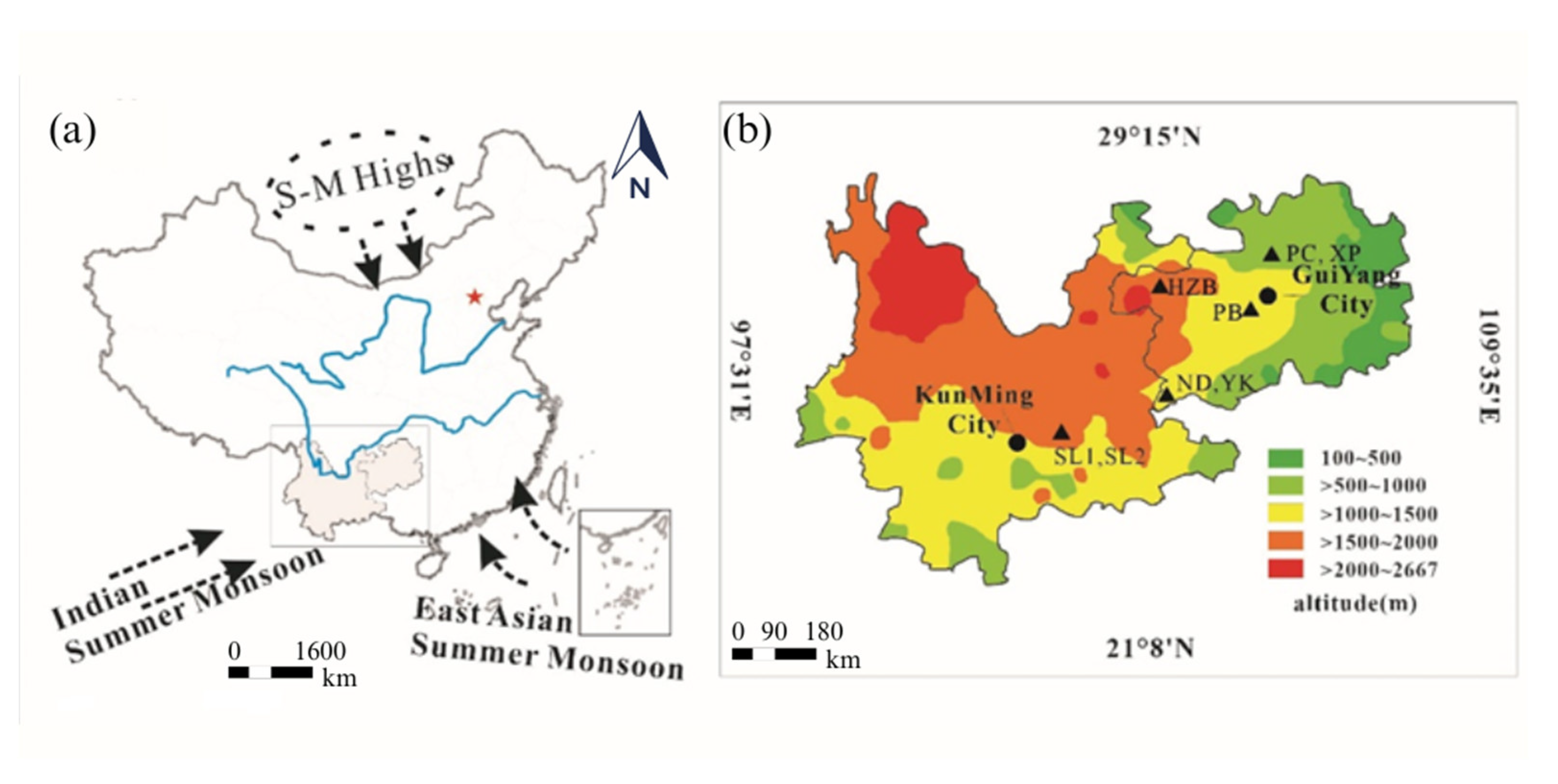
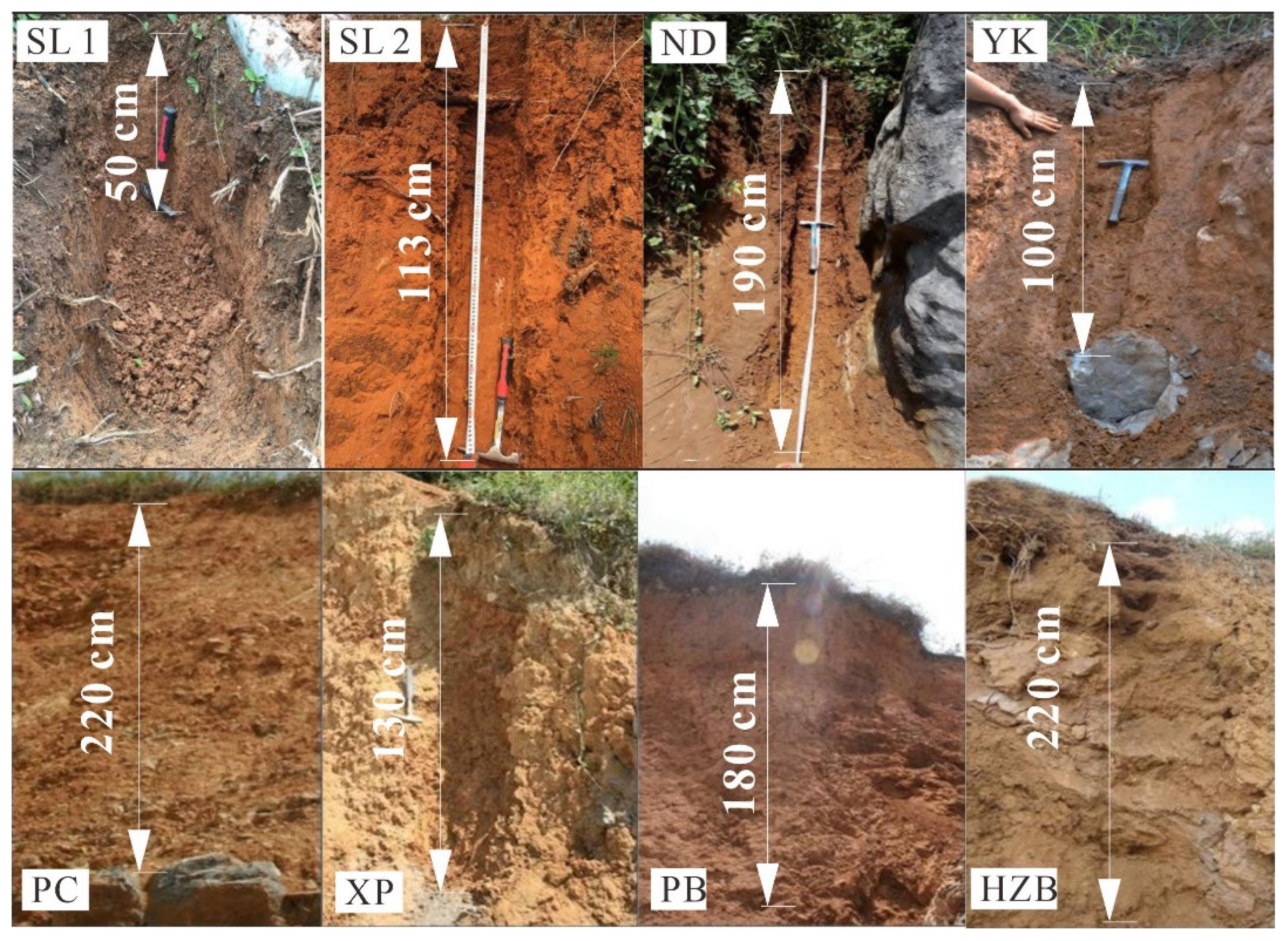
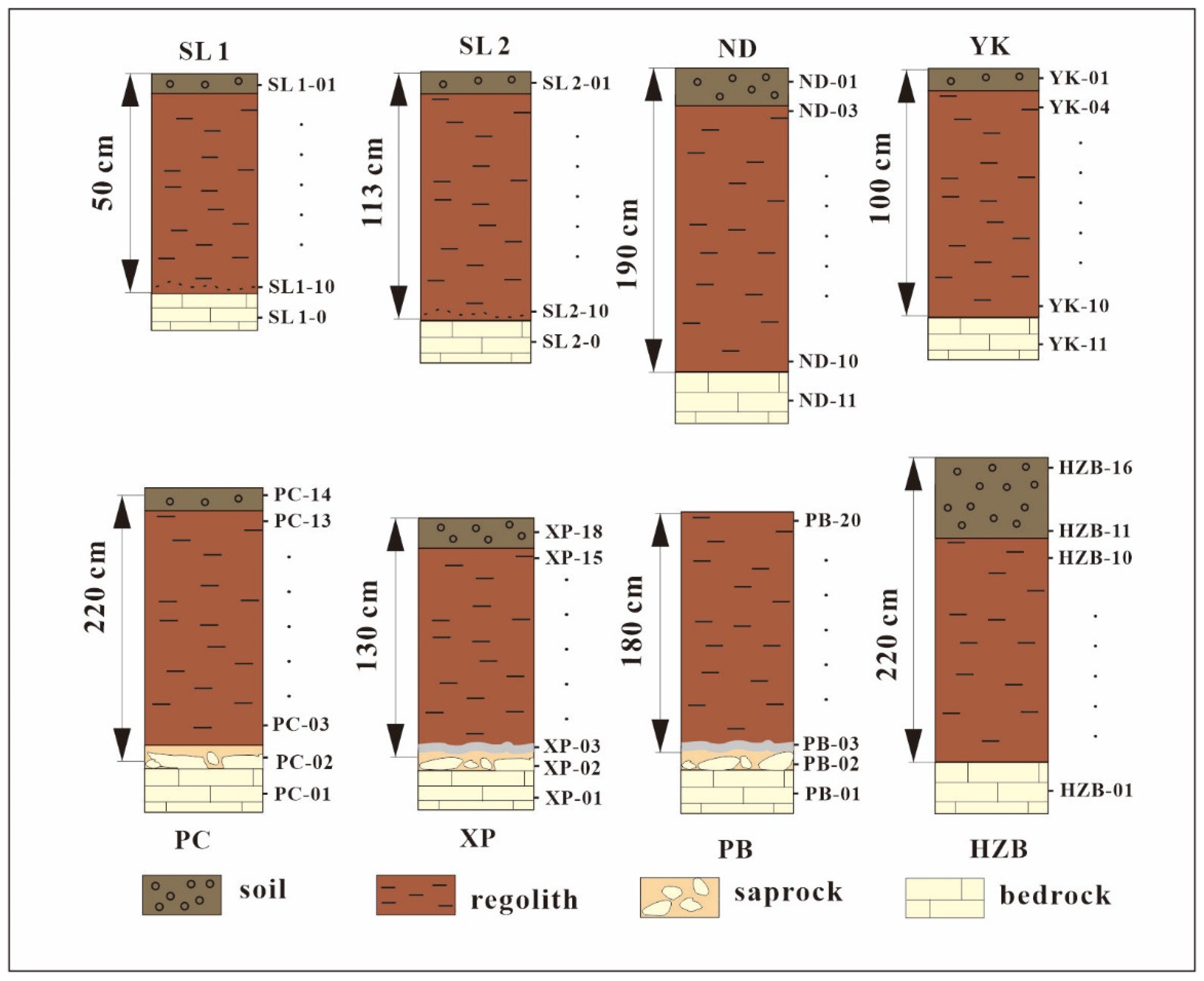
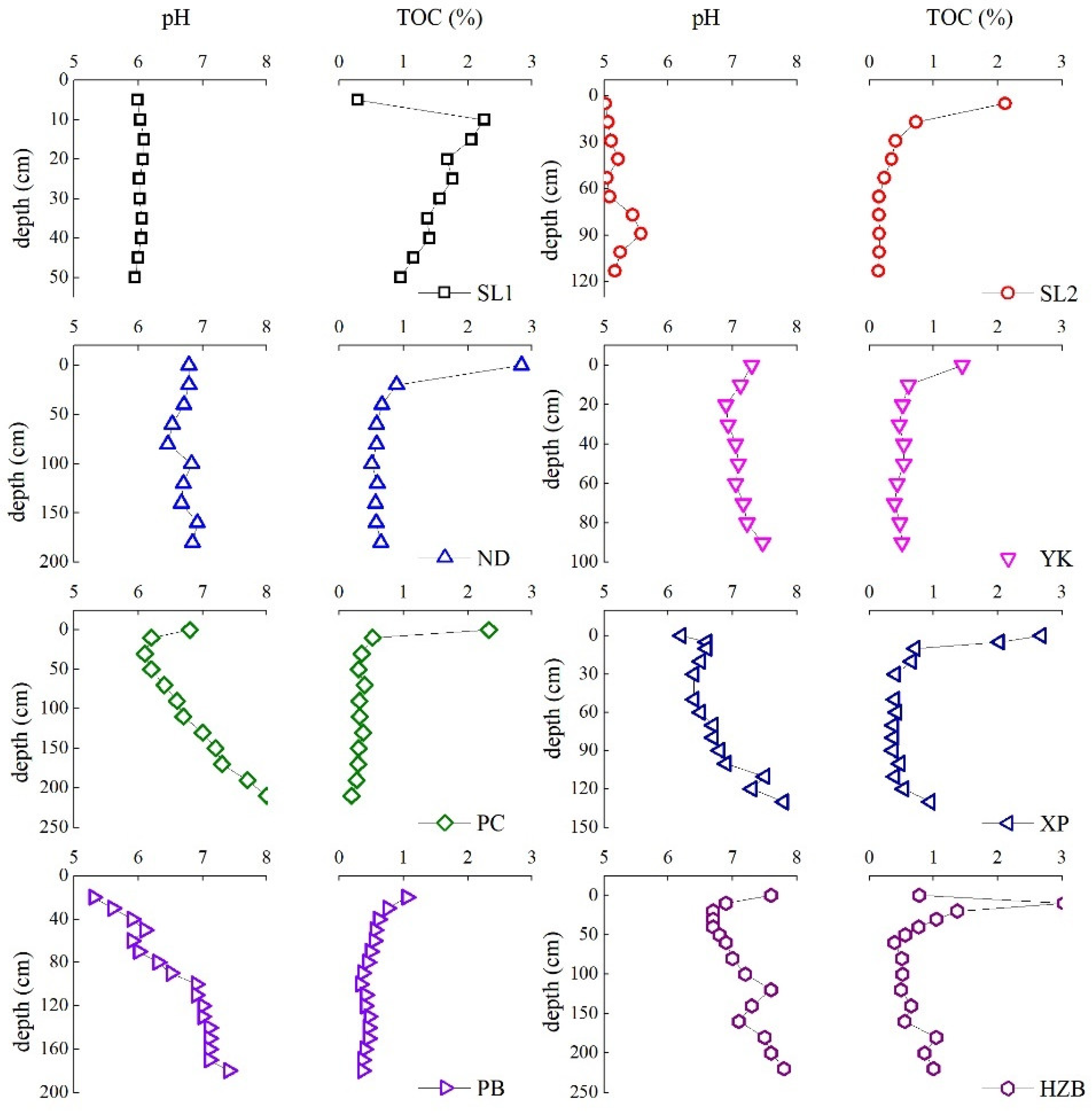
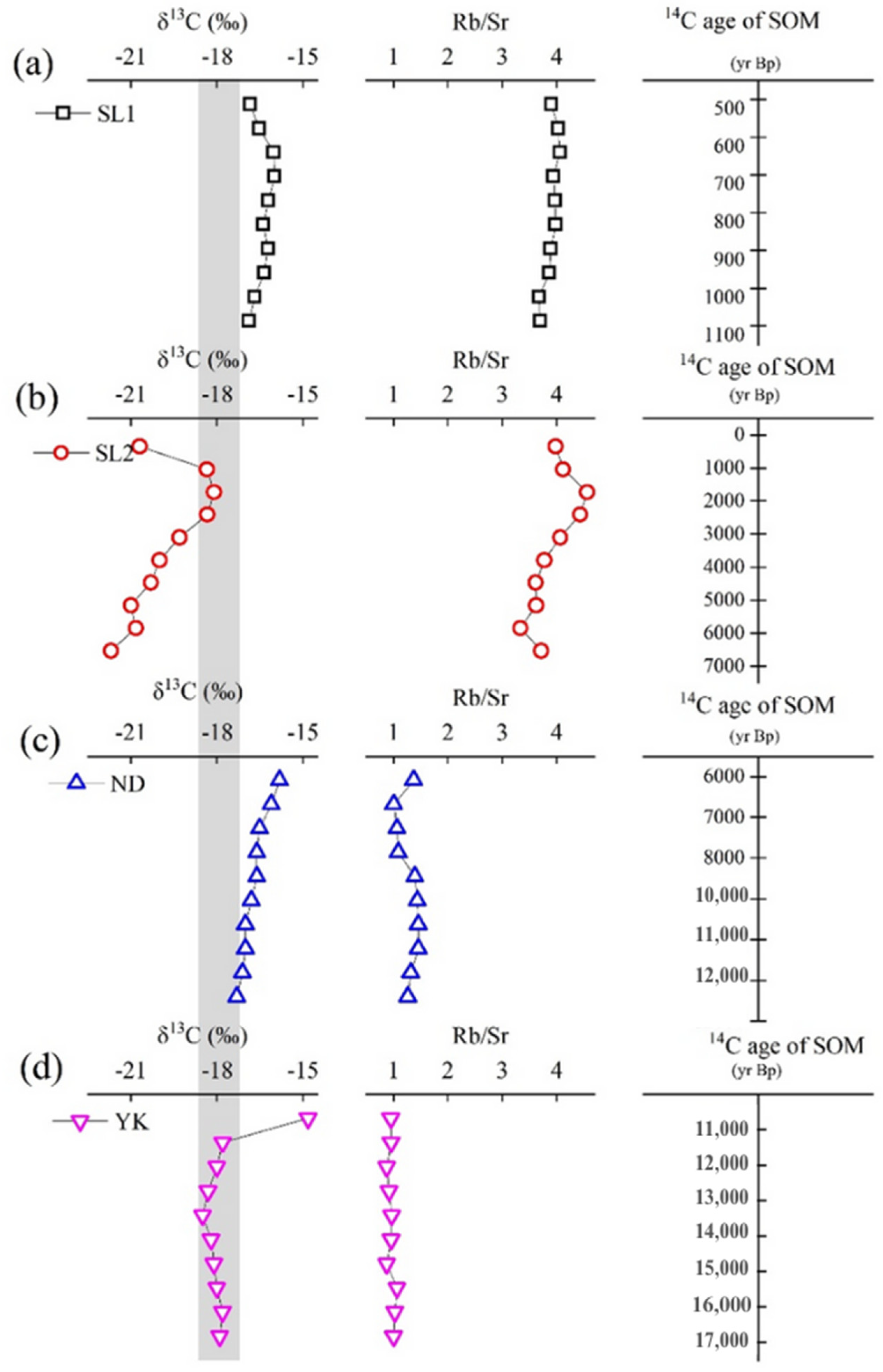
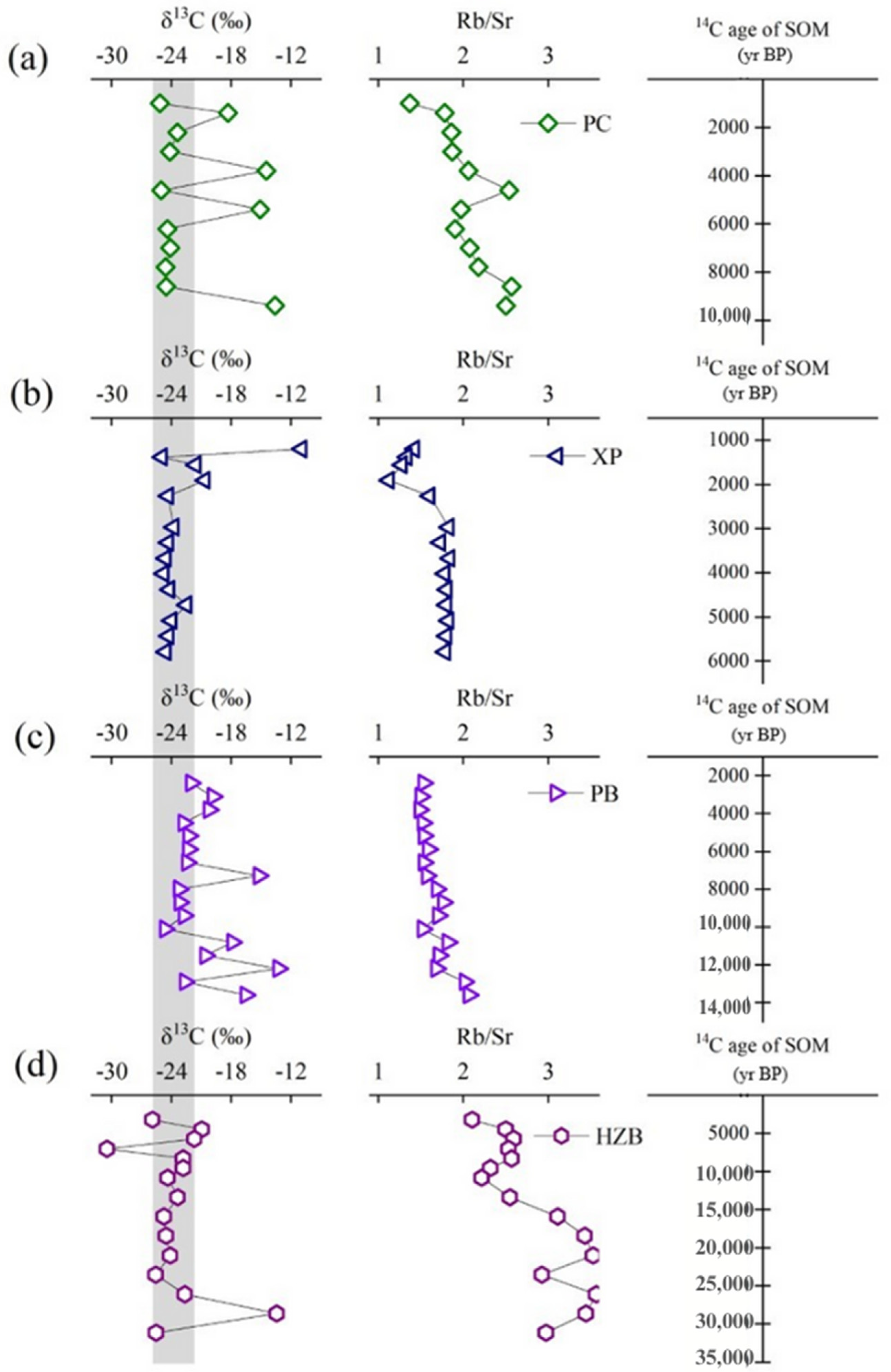
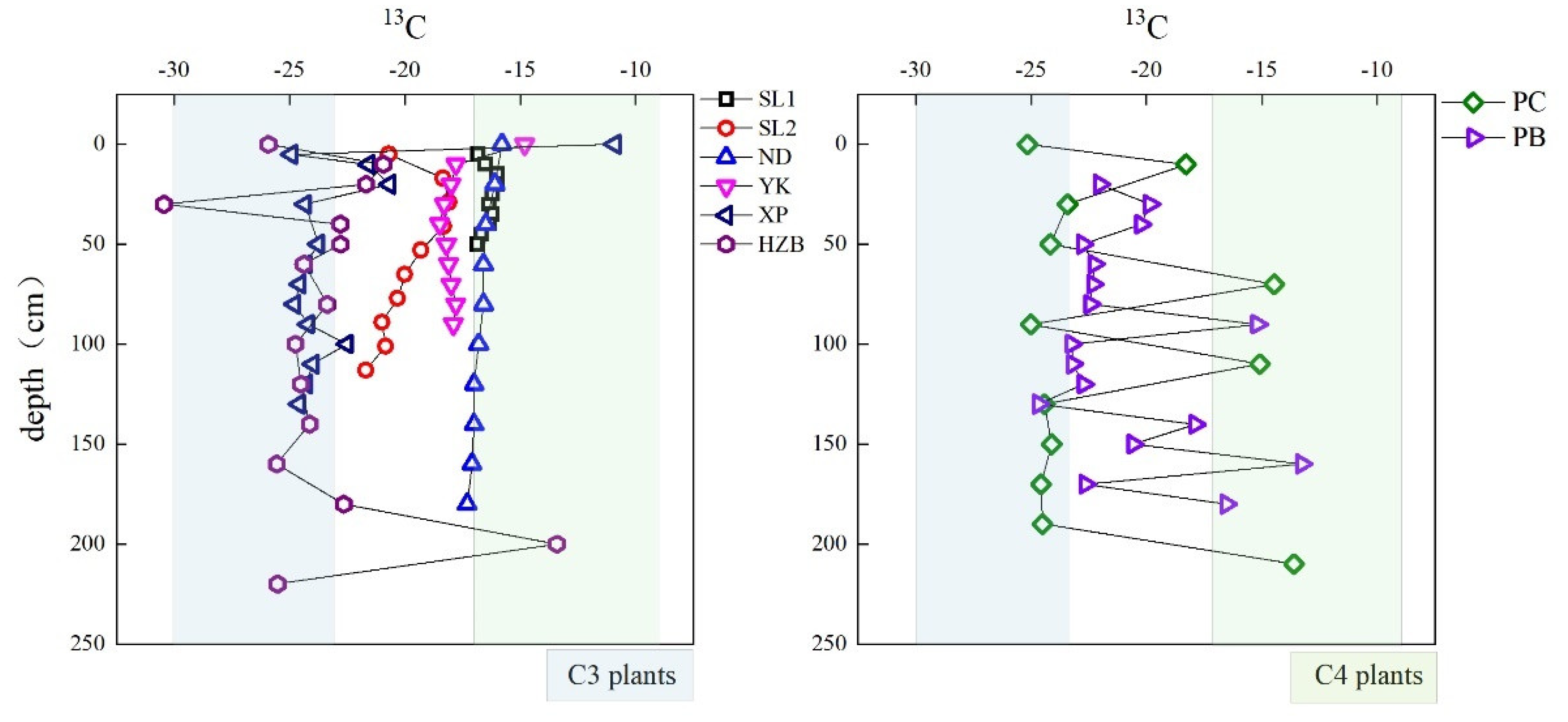

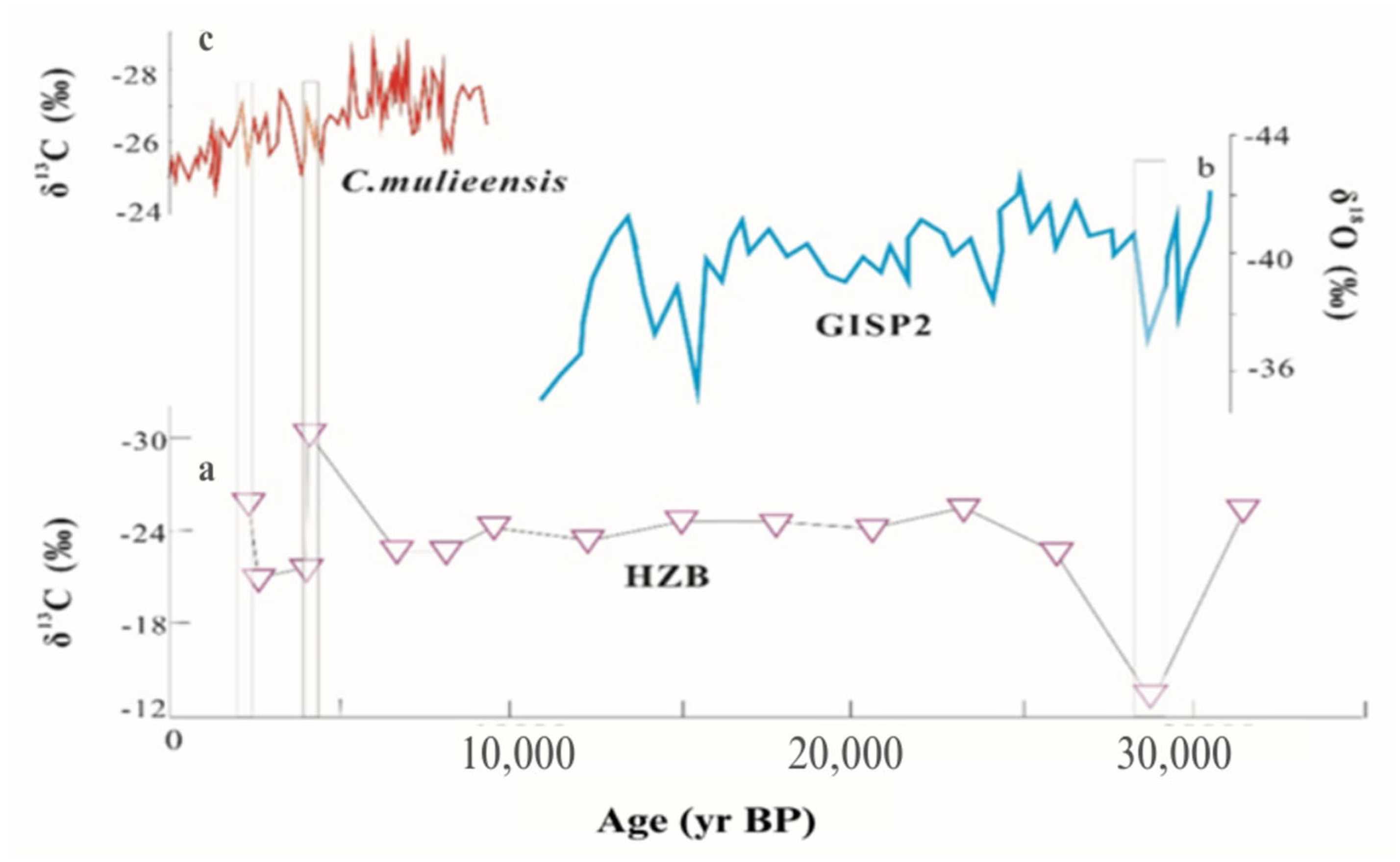
| Soil Profiles | Location | Elevation (m) | Thickness (cm) | Parent Material | Soil Texture | Visible Characteristics |
|---|---|---|---|---|---|---|
| SL1 | 24°48′ N; 103°18′ E | 1770 | 50 | Limestone | Silty clay loam | Dark brown |
| SL2 | 24°48′ N; 103°18′ E | 1730 | 113 | Limestone | Silty loam | Red |
| ND | 24°49′ N; 104°51′ E | 1279 | 190 | Carbonate | Silty loam | Red |
| YK | 24°49′ N; 104°51′ E | 1116 | 100 | Carbonate | Silty clay loam | Reddish brown |
| PC | 27°51′ N; 107°02′ E | 951 | 220 | Limestone lower Triassic | Silty clay loam | Yellowish brown |
| XP | 27°44′ N; 107°03′ E | 853 | 150 | Dolomite upper Cambrian | Clayey loam | Red brown |
| PB | 26°25′ N; 106°21′ E | 1256 | 200 | Dolomite lower Triassic | Silty loam | Red |
| HZB | 27°08′ N; 104°43′ E | 1689 | 220 | Limestone lower Permian | Silty clay loam | Yellowish brown |
| Sample Profiles | Soil Depth (cm) | pH | TOC (%) | δ13C (‰) | pMC (%) | Error (1σ) | 14C Age (yrs BP) | Error (1σ) | Rb (µg/g) | Sr (µg/g) | Rb/Sr |
|---|---|---|---|---|---|---|---|---|---|---|---|
| SL1-1 | 5 | 5.99 | 0.286 | −16.831 | 94 | 0.23 | 500 | 20 | 93.7 | 24 | 3.90 |
| SL1-2 | 10 | 6.025 | 2.255 | −16.517 | 91.8 | 22.8 | 4.02 | ||||
| SL1-3 | 15 | 6.09 | 2.051 | −16.008 | 92.59 | 0.24 | 620 | 20 | 97.8 | 24.1 | 4.05 |
| SL1-4 | 20 | 6.075 | 1.676 | −15.984 | 94.7 | 24 | 3.94 | ||||
| SL1-5 | 25 | 6.015 | 1.764 | −16.204 | 91.45 | 0.24 | 720 | 20 | 94.9 | 23.9 | 3.97 |
| SL1-6 | 30 | 6.02 | 1.56 | −16.367 | 99.2 | 24.9 | 3.98 | ||||
| SL1-7 | 35 | 6.055 | 1.372 | −16.219 | 89.5 | 0.24 | 890 | 20 | 99.2 | 25.5 | 3.89 |
| SL1-8 | 40 | 6.04 | 1.41 | −16.345 | 95.9 | 24.8 | 3.86 | ||||
| SL1-9 | 45 | 5.995 | 1.157 | −16.683 | 91.21 | 0.25 | 740 | 20 | 97.8 | 26.6 | 3.67 |
| SL1-10 | 50 | 5.945 | 0.953 | −16.874 | 91 | 24.6 | 3.69 | ||||
| SL1-0 | 100 | nd | nd | nd | 1.15 | 47.2 | 0.02 | ||||
| SL2-1 | 5 | 5.02 | 2.118 | −20.698 | 98.92 | 0.26 | 90 | 20 | 78.5 | 19.7 | 3.98 |
| SL2-2 | 17 | 5.065 | 0.729 | −18.345 | 90.62 | 0.24 | 790 | 20 | 85.7 | 20.8 | 4.12 |
| SL2-3 | 29 | 5.11 | 0.413 | −18.103 | 81.71 | 0.26 | 1620 | 25 | 91.7 | 20.1 | 4.56 |
| SL2-4 | 41 | 5.22 | 0.351 | −18.34 | 82.77 | 0.26 | 1520 | 25 | 82.5 | 18.6 | 4.43 |
| SL2-5 | 53 | 5.05 | 0.24 | −19.307 | 68.47 | 0.2 | 3040 | 25 | 75.3 | 18.5 | 4.07 |
| SL2-6 | 65 | 5.085 | 0.153 | −20.001 | 70.7 | 18.7 | 3.78 | ||||
| SL2-7 | 77 | 5.445 | 0.154 | −20.314 | 69.1 | 19.1 | 3.61 | ||||
| SL2-8 | 89 | 5.575 | 0.158 | −21.001 | 71 | 19.6 | 3.62 | ||||
| SL2-9 | 101 | 5.255 | 0.16 | −20.83 | 76 | 22.8 | 3.33 | ||||
| SL2-10 | 113 | 5.17 | 0.145 | −21.696 | 81.1 | 21.8 | 3.72 | ||||
| SL2-0 | 163 | nd | nd | nd | 0.601 | 69.9 | 0.008 | ||||
| ND-1 | 0 | 6.79 | 2.835 | −15.8 | 85.08 | 0.23 | 1300 | 20 | 116 | 84.4 | 1.37 |
| ND-2 | 20 | 6.79 | 0.895 | −16.1 | 47.68 | 0.23 | 5950 | 40 | 79.1 | 78.4 | 1.008 |
| ND-3 | 40 | 6.71 | 0.669 | −16.5 | 48.01 | 0.17 | 5895 | 30 | 89.3 | 83.2 | 1.073 |
| ND-4 | 60 | 6.53 | 0.584 | −16.6 | 39.84 | 0.16 | 7390 | 30 | 91.5 | 83.8 | 1.091 |
| ND-5 | 80 | 6.46 | 0.583 | −16.6 | 37.54 | 0.17 | 7870 | 35 | 115 | 82.2 | 1.39 |
| ND-6 | 100 | 6.83 | 0.509 | −16.8 | 108 | 74.8 | 1.44 | ||||
| ND-7 | 120 | 6.7 | 0.591 | −17 | 108 | 73.8 | 1.46 | ||||
| ND-8 | 140 | 6.67 | 0.565 | −17 | 114 | 78.1 | 1.45 | ||||
| ND-9 | 160 | 6.92 | 0.576 | −17.1 | 109 | 82.4 | 1.32 | ||||
| ND-10 | 180 | 6.84 | 0.644 | −17.3 | 102 | 80.1 | 1.27 | ||||
| ND-11 | 190 | nd | nd | nd | 6.43 | 200 | 0.03 | ||||
| YK-1 | 0 | 7.3 | 1.443 | −14.8 | 71.99 | 0.21 | 2640 | 25 | 131 | 137 | 0.95 |
| YK-2 | 10 | 7.12 | 0.612 | −17.8 | 156 | 162 | 0.96 | ||||
| YK-3 | 20 | 6.9 | 0.521 | −18 | 22.89 | 0.11 | 11845 | 40 | 143 | 162 | 0.88 |
| YK-4 | 30 | 6.93 | 0.473 | −18.3 | 145 | 157 | 0.92 | ||||
| YK-5 | 40 | 7.05 | 0.539 | −18.5 | 19.76 | 0.11 | 13025 | 45 | 158 | 163 | 0.96 |
| YK-6 | 50 | 7.09 | 0.542 | −18.2 | 153 | 158 | 0.96 | ||||
| YK-7 | 60 | 7.05 | 0.433 | −18.1 | 15.78 | 0.09 | 14835 | 45 | 152 | 172 | 0.88 |
| YK-8 | 70 | 7.17 | 0.39 | −18 | 166 | 155 | 1.07 | ||||
| YK-9 | 80 | 7.23 | 0.477 | −17.8 | 23.46 | 0.12 | 11645 | 40 | 160 | 155 | 1.03 |
| YK-10 | 90 | 7.47 | 0.511 | −17.9 | 152 | 150 | 1.01 | ||||
| YK-11 | 100 | nd | nd | nd | 1.15 | 220 | 0.005 | ||||
| PC-14 | 0 | 6.8 | 2.33 | −25.15 | 82.99 | 0.21 | 1498 | 20 | 88.3 | 64.4 | 1.37 |
| PC-13 | 10 | 6.2 | 0.52 | −18.29 | 45.09 | 0.15 | 6399 | 27 | 82.7 | 46.4 | 1.78 |
| PC-12 | 30 | 6.1 | 0.35 | −23.42 | 78.9 | 42.4 | 1.86 | ||||
| PC-11 | 50 | 6.2 | 0.3 | −24.16 | 77.7 | 41.5 | 1.87 | ||||
| PC-10 | 70 | 6.4 | 0.39 | −14.46 | 88.5 | 42.9 | 2.06 | ||||
| PC-9 | 90 | 6.6 | 0.31 | −25.01 | 102 | 40.1 | 2.54 | ||||
| PC-8 | 110 | 6.7 | 0.32 | −15.08 | 77.4 | 39.2 | 1.97 | ||||
| PC-7 | 130 | 7 | 0.37 | −24.42 | 28.71 | 0.11 | 10025 | 32 | 76.3 | 40.1 | 1.90 |
| PC-6 | 150 | 7.2 | 0.3 | −24.11 | 78.3 | 37.7 | 2.07 | ||||
| PC-5 | 170 | 7.3 | 0.29 | −24.57 | 76.3 | 35 | 2.18 | ||||
| PC-4 | 190 | 7.7 | 0.27 | −24.51 | 89 | 34.6 | 2.57 | ||||
| PC-3 | 210 | 8 | 0.19 | −13.6 | 70.5 | 28.2 | 2.50 | ||||
| PC-2 | 220 | 8.2 | nd | nd | 2.21 | 51.2 | 0.04 | ||||
| PC-1 | nd | 8.4 | nd | nd | 1.71 | 1220 | 0.001 | ||||
| XP-18 | 0 | 6.2 | 2.68 | −10.91 | 104.75 | 0.26 | Modern | nd | nd | nd | |
| XP-17 | 5 | 6.6 | 2.03 | −24.93 | 75 | 52.7 | 1.42 | ||||
| XP-16 | 10 | 6.6 | 0.72 | −21.57 | 88.48 | 0.22 | 983 | 20 | 68.8 | 51.5 | 1.33 |
| XP-15 | 20 | 6.5 | 0.66 | −20.66 | 67.9 | 53.1 | 1.27 | ||||
| XP-14 | 30 | 6.4 | 0.41 | −24.32 | 63.3 | 56.2 | 1.12 | ||||
| XP-13 | 50 | 6.4 | 0.4 | −23.76 | 88.3 | 55 | 1.60 | ||||
| XP-12 | 60 | 6.5 | 0.43 | −24.3 | 103 | 56.3 | 1.82 | ||||
| XP-11 | 70 | 6.7 | 0.38 | −24.55 | 100 | 57.8 | 1.73 | ||||
| XP-10 | 80 | 6.7 | 0.38 | −24.79 | 48.13 | 0.14 | 5875 | 24 | 107 | 58.1 | 1.84 |
| XP-9 | 90 | 6.8 | 0.37 | −24.2 | 103 | 57.8 | 1.78 | ||||
| XP-8 | 100 | 6.9 | 0.48 | −22.5 | 109 | 60.4 | 1.80 | ||||
| XP-7 | 110 | 7.5 | 0.4 | −24 | 107 | 59.4 | 1.80 | ||||
| XP-6 | 120 | 7.3 | 0.54 | −24.27 | 110 | 60.2 | 1.82 | ||||
| XP-5 | 130 | 7.8 | 0.95 | −24.59 | 57.33 | 0.18 | 4470 | 26 | 114 | 63.3 | 1.80 |
| XP-4 | nd | 8.2 | nd | nd | 123 | 68.9 | 1.78 | ||||
| XP-3 | nd | 9.7 | nd | nd | 124 | 62.3 | 1.99 | ||||
| XP-2 | nd | 9.2 | nd | nd | 1.5 | 50.7 | 0.02 | ||||
| XP-1 | nd | 9.1 | nd | nd | 16.2 | 48.5 | 0.33 | ||||
| PB-20 | 20 | 5.3 | 1.05 | −22.04 | 74.61 | 0.2 | 2353 | 21 | 83 | 54.2 | 1.53 |
| PB-19 | 30 | 5.6 | 0.75 | −19.87 | 82.3 | 54.9 | 1.49 | ||||
| PB-18 | 40 | 5.9 | 0.61 | −20.24 | 80.9 | 54.5 | 1.48 | ||||
| PB-17 | 50 | 6.1 | 0.55 | −22.76 | 84.3 | 55.4 | 1.52 | ||||
| PB-16 | 60 | 5.9 | 0.54 | −22.26 | 80.5 | 52.4 | 1.53 | ||||
| PB-15 | 70 | 6 | 0.48 | −22.33 | 83.8 | 52.9 | 1.58 | ||||
| PB-14 | 80 | 6.3 | 0.44 | −22.44 | 81.8 | 53.3 | 1.53 | ||||
| PB-13 | 90 | 6.5 | 0.36 | −15.2 | 80.8 | 51.5 | 1.56 | ||||
| PB-12 | 100 | 6.9 | 0.33 | −23.25 | 31.94 | 0.13 | 9169 | 33 | 89.4 | 52.9 | 1.68 |
| PB-11 | 110 | 6.9 | 0.41 | −23.19 | 91.9 | 52.1 | 1.76 | ||||
| PB-10 | 120 | 7 | 0.4 | −22.73 | 88.4 | 51.9 | 1.70 | ||||
| PB-9 | 130 | 7 | 0.46 | −24.67 | 69.8 | 45.9 | 1.52 | ||||
| PB-8 | 140 | 7.1 | 0.45 | −17.89 | 93.4 | 51.4 | 1.81 | ||||
| PB-7 | 150 | 7.1 | 0.45 | −20.59 | 89 | 52 | 1.71 | ||||
| PB-6 | 160 | 7.1 | 0.39 | −13.27 | 22.78 | 0.1 | 11885 | 35 | 88.5 | 52.5 | 1.68 |
| PB-5 | 170 | 7.1 | 0.36 | −22.65 | 105 | 52 | 2.01 | ||||
| PB-4 | 180 | 7.4 | 0.36 | −16.54 | 108 | 52.3 | 2.06 | ||||
| PB-3 | nd | 8.8 | nd | nd | 3.85 | 74 | 0.05 | ||||
| PB-2 | nd | 9 | nd | nd | 3.43 | 76.7 | 0.04 | ||||
| PB-1 | nd | 10 | nd | nd | 2.2 | 67.9 | 0.03 | ||||
| HZB-16 | 0 | 7.6 | 0.78 | −25.92 | 74.26 | 0.19 | 2390 | 21 | 98.00 | 46.53 | 2.10 |
| HZB-15 | 10 | 6.9 | 3.03 | −20.94 | 105.83 | 42.29 | 2.50 | ||||
| HZB-14 | 20 | 6.7 | 1.37 | −21.68 | 107.86 | 41.52 | 2.59 | ||||
| HZB-13 | 30 | 6.7 | 1.05 | −30.45 | 60.08 | 0.19 | 4093 | 25 | 104.29 | 41.10 | 2.53 |
| HZB-12 | 40 | 6.7 | 0.77 | −22.8 | 104.77 | 40.77 | 2.56 | ||||
| HZB-11 | 50 | 6.8 | 0.56 | −22.8 | 102.17 | 44.04 | 2.32 | ||||
| HZB-10 | 60 | 6.9 | 0.39 | −24.38 | 88.09 | 39.71 | 2.21 | ||||
| HZB-9 | 80 | 7 | 0.51 | −23.37 | 103.58 | 40.59 | 2.55 | ||||
| HZB-8 | 100 | 7.2 | 0.52 | −24.75 | 119.16 | 38.27 | 3.11 | ||||
| HZB-7 | 120 | 7.6 | 0.49 | −24.51 | 123.75 | 36.03 | 3.43 | ||||
| HZB-6 | 140 | 7.3 | 0.65 | −24.13 | 7.69 | 0.06 | 20605 | 63 | 117.52 | 33.30 | 3.52 |
| HZB-5 | 160 | 7.1 | 0.55 | −25.56 | 111.85 | 38.19 | 2.92 | ||||
| HZB-4 | 180 | 7.5 | 1.04 | −22.66 | 134.59 | 37.70 | 3.57 | ||||
| HZB-3 | 200 | 7.6 | 0.86 | −13.41 | 139.58 | 40.47 | 3.44 | ||||
| HZB-2 | 220 | 7.8 | 1 | −25.51 | 120.73 | 40.54 | 2.97 | ||||
| HZB-1 | nd | 10.1 | nd | nd | 0.33 | 258.37 | 0.001 |
Disclaimer/Publisher’s Note: The statements, opinions and data contained in all publications are solely those of the individual author(s) and contributor(s) and not of MDPI and/or the editor(s). MDPI and/or the editor(s) disclaim responsibility for any injury to people or property resulting from any ideas, methods, instructions or products referred to in the content. |
© 2023 by the authors. Licensee MDPI, Basel, Switzerland. This article is an open access article distributed under the terms and conditions of the Creative Commons Attribution (CC BY) license (https://creativecommons.org/licenses/by/4.0/).
Share and Cite
Beckford, H.O.; Chang, C.; Ji, H. Determination of Paleoenvironmental Changes by Using δ13C, 14C Dating and Rb/Sr Ratio in Critical Karst Area of Yunnan-Guizhou Plateau, Southwestern China. Sustainability 2023, 15, 6480. https://doi.org/10.3390/su15086480
Beckford HO, Chang C, Ji H. Determination of Paleoenvironmental Changes by Using δ13C, 14C Dating and Rb/Sr Ratio in Critical Karst Area of Yunnan-Guizhou Plateau, Southwestern China. Sustainability. 2023; 15(8):6480. https://doi.org/10.3390/su15086480
Chicago/Turabian StyleBeckford, Howard Omar, Cheng Chang, and Hongbing Ji. 2023. "Determination of Paleoenvironmental Changes by Using δ13C, 14C Dating and Rb/Sr Ratio in Critical Karst Area of Yunnan-Guizhou Plateau, Southwestern China" Sustainability 15, no. 8: 6480. https://doi.org/10.3390/su15086480
APA StyleBeckford, H. O., Chang, C., & Ji, H. (2023). Determination of Paleoenvironmental Changes by Using δ13C, 14C Dating and Rb/Sr Ratio in Critical Karst Area of Yunnan-Guizhou Plateau, Southwestern China. Sustainability, 15(8), 6480. https://doi.org/10.3390/su15086480






